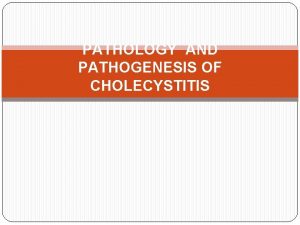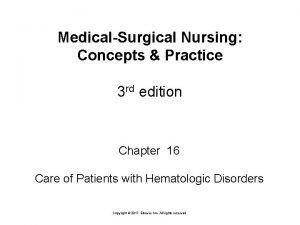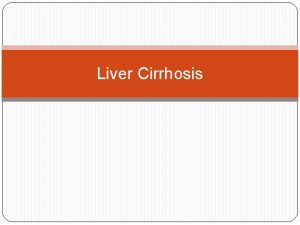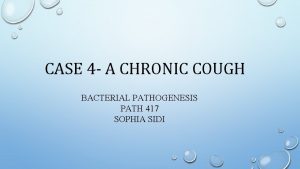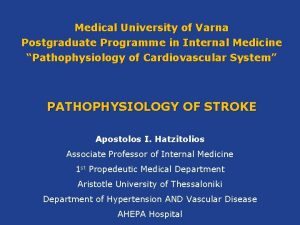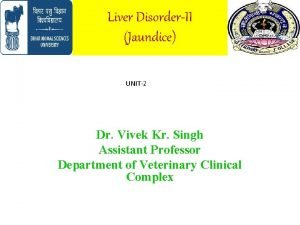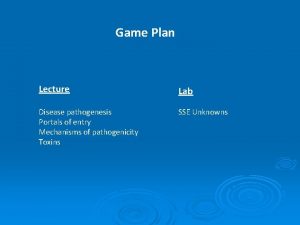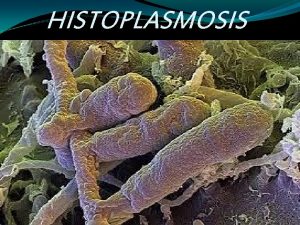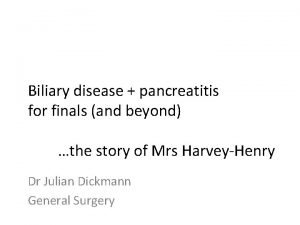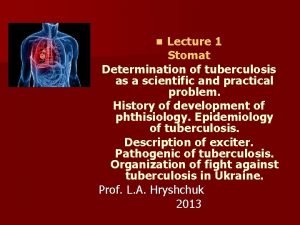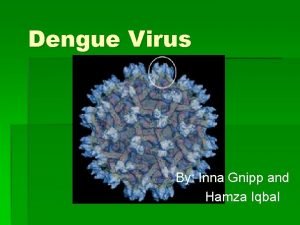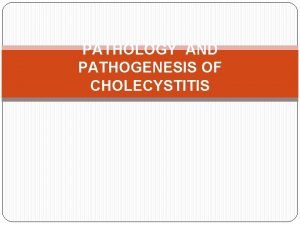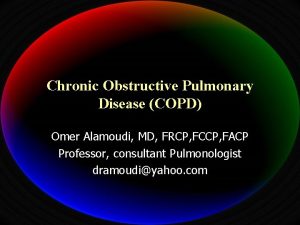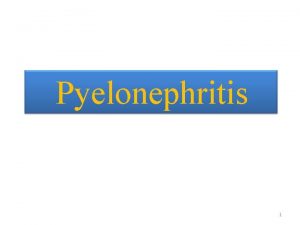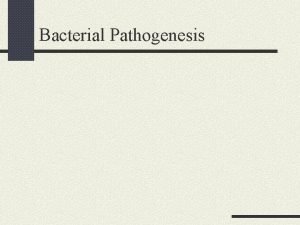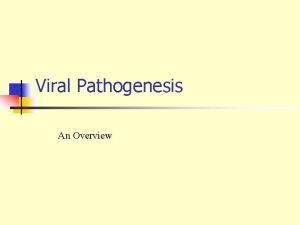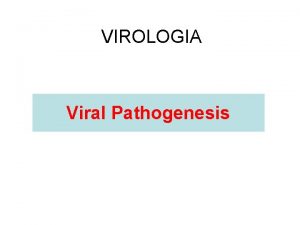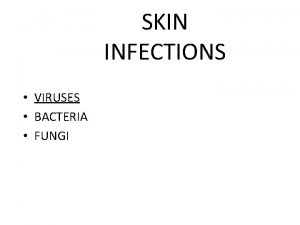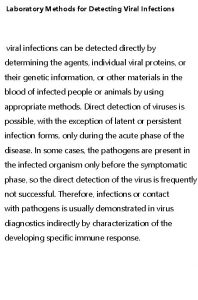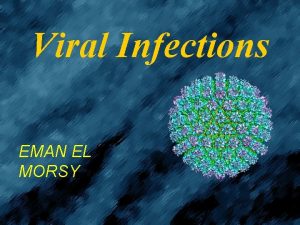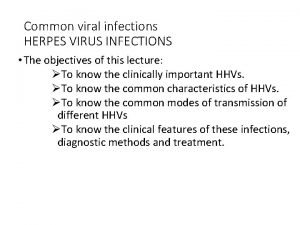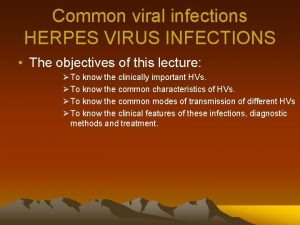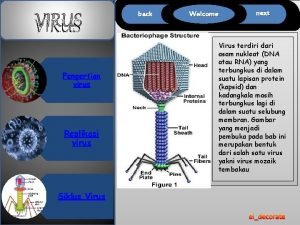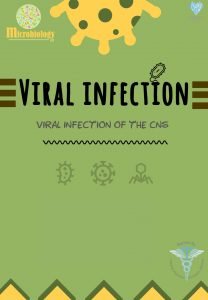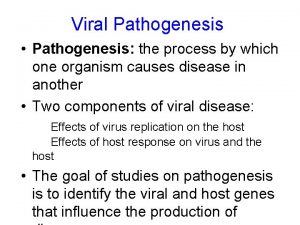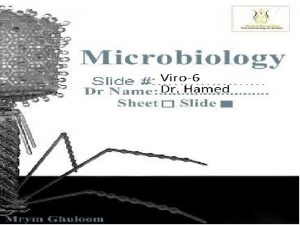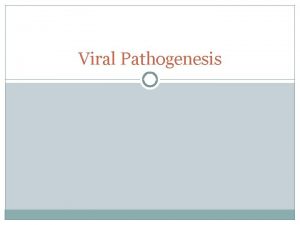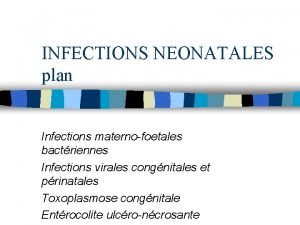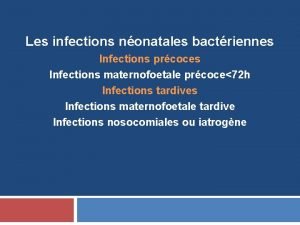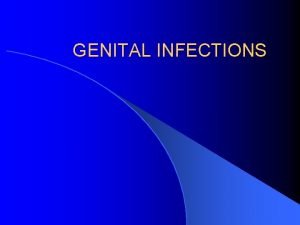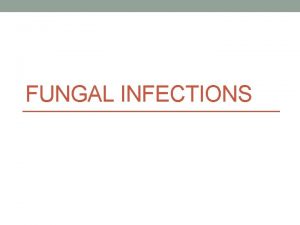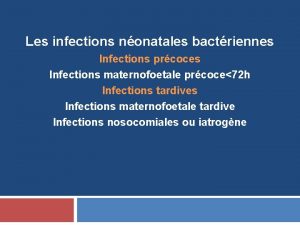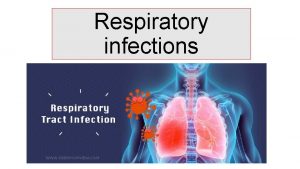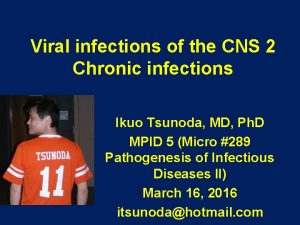Pathogenesis of Viral Infections Viral pathogenesis No virus



































- Slides: 35

Pathogenesis of Viral Infections

Viral pathogenesis “No virus is known to do good. It has been well said that a virus is a piece of bad news wrapped up in protein. ” Medawar and Medawar

Viral Pathogenesis n Viral pathogenesis is the process by which a viral infection leads to disease. n Viral pathogenesis is an abnormal situation of no value to the virus. n The majority of viral infections are subclinical. It is not in the interest of the virus to severely harm or kill the host. n The consequences of viral infections depend on the interplay between a number of viral and host factors.

Infection Vs Disease n n INFECTION: –Entry of virus into the body, produces no symptoms or transient symptoms due to local irritation DISEASE: –Virus at Target organ, produces signs and symptoms associated with disease

Basic Concepts n Pathogenesis is a result of: • injury to discrete populations of cells • in particular target organs • producing signs & symptoms of disease in a given host. n Extent of disease depends on: • Virus dose • Route of entry • Replication efficiency

n Both the host & the virus are seeking a reproductive advantage • new viruses are evolving continuously • natural selection favors viruses with low pathogenicity /virulence (so they don't eradicate their hosts) § Most viral infections are asymptomatic § Disease is an “unusual” consequence of infection.

Introduction n Viral pathogenesis concerns itself with the mechanisms by which viruses cause injury to cells in different tissues and organs to produce the signs and symptoms of disease. Considering viral diseases, there are two components involved, the direct effect of virus replication and the effects of bodily responses to the infection. The course of any virus infection is determined by a delicate and dynamic balance between the host and the virus.

n n n In some viral infections, most of the pathologic symptoms observed are attributable to the side effects of the immune response. Inflammation, fever, headache and skin rashes are usually caused by the cells of the immune system due to the release of potent chemicals such as interferon and interleukins. The vast majority of virus infections are silent and do not result in outward signs of disease.

n n With many virulent viruses, subclinical or unapparent infections often outnumber cases of symptomatic illness. However, for certain classic viral infections, such as measles, smallpox, rabies, and influenza almost all infected individuals develop disease. It is perfectly possible to envisage viruses with a hitand-run strategy, moving quickly form one host to the next and relying on continuing circulation for their survival. Nevertheless, there is a clear tendency for viruses not to injure their hosts if possible.

Mechanisms of cellular injury q n n n n In general terms, a number of common phenotypic changes can be recognized in virus-infected cells. These are often referred to as CPE and include: Altered shape (rounding). Detachment from the substrate. Membrane fusion (giant cells, syncytium). Increased membrane permeability. Inclusion body formation. Lysis. Apoptosis.

n n Pathogenic mechanisms include implantation of the virus at a body site (the portal of entry), replication at that site, and then spread to and multiplication within sites (target organs) where disease or shedding of virus into the environment occurs. Most viral infections are subclinical, suggesting that body defense against viruses arrest most infections before disease symptoms become manifest.

n n Knowledge of subclinical infections comes from serologic studies showing that sizeable portions of the population have specific antibodies to viruses even though the individuals have no history of disease. Unapparent infections have great epidemiologic importance; they constitute major sources for dissemination of virus through the population and they confer immunity.

HOST factors which modify viral pathogenesis • Virus receptors - genetically determined or due to the state of differentiation. • Age - certain infections are more severe in different age groups. - less severe before puberty, e. g. EBV infections and mononucleosis, measles, VZV (chickenpox) and poliomyelitis.

• Metabolic state q Generalized malnutrition or Vitamin A deficiency increase susceptibility to, and severity of, measles infection. q Pregnancy (with its associated change in hormonal balance) can also lead to altered susceptibility to certain viruses. • “Altered” immune responses - Impaired (Congenital or Acquired) - Enhanced (Auto-immunity) q

n Routes of entry • Skin • Respiratory tract • Gastrointestinal tract • Genitourinary tract • Conjunctiva

Skin n n May be penetrated by viruses as a result of - mechanical trauma (HPV, HIV, HSV, HBV, poxvirus) - by injection (HBV, HIV) - by the bite of an infected mosquito (arboviruses) - by the bite of an infected animal (rabies) Generally, viruses do not multiply locally but are carried away from site of infection: - by bloodstream (HBV, arboviruses) - or migration along nerves (rabies)

n n n Respiratory Tract Major route of invasion: For viruses causing local respiratory infections - influenza, RSV, rhinoviruses Others causing asymptomatic initial infection then generalized spread - measles, mumps, chickenpox, enteroviruses Transmission usually by droplet infection in aerosols

n n Gastrointestinal Tract Entry via GI tract may involve • local infection (rotavirus, coronavirus, adenovirus) or • invasion of the host to produce systemic illness (enteroviruses, hepatitis A) Virus survival depends on: - acid stability - resistance to bile salts - inactivation by proteolytic enzymes, in some cases a requirement! Mostly non-enveloped

n Genitourinary Tract n Tears or abrasions of mucosa allow viral entry n n Sexually transmitted viruses • HIV • herpes simplex (mostly HSV II) • papillomaviruses (genital warts) • hepatitis B virus Nature of cervical mucus, the p. H of vaginal secretions and the chemical composition of urine all play a role in host defense.

Localization vs systemic spread n Many viruses multiply in epithelial cells at site of entry, produce a spreading infection then are shed directly to the exterior • Respiratory infections – influenza, rhinoviruses and RSV • Gastrointestinal infections caused by rotaviruses • Dermatologic infections of the papillomaviruses

q n n Targeting of viral budding to apical or basal surfaces of polarized cells may define subsequent spread Baso -lateral budding (Rhabdo and Retroviruses) Apical budding (Orthomyxo and paramyxoviruses)

q. Spread § Cell-to-cell. § Blood stream: - free or cell associated viremia. Primary Vs secondary viremia. § Neural spread: - usually preceded by primary viremia but may be direct (rabies). q Cell and tissues tropism is a major determinant of spread.

n n n After traversing the epithelium and its basement membrane at the body surface, invading viruses face multiple tissue and cellular defenses • enter directly into blood stream (arboviruses) • initially taken up by the lymphatic system Viruses may also enter directly into peripheral nerves (rabies) Invasion of mucosal tissue and subsequent spread by the bloodstream results ultimately in the infection of particular target organs

n Incubation period ends with the onset of symptoms • from a few days (localized infections – paramyxoviruses • to a few weeks (systemic infections chickenpox, hepatitis A) • or years (chronic, persistent and “slow” viruses)

VIRUS SHEDDING AND TRANSMISSION n Horizontal: From host to host of the same generation 1. Direct: host to host by contact • skin lesions – papillomavirus • saliva – rabies, mumps, CMV, EBV, HIV • mechanical trauma – HIV, HSV • aerosols - influenza, measles, rhinoviruses 2. Indirect: host to fomites (food, water, needles, vector-mediated) to host - hepatitis A, polio, hepatitis B and yellow fever

Vertical: From host to progeny - Congenital transmission (Rubella, Cytomegalovirus, HIV) 1. Transplacental: CMV, parvovirus B 19 cross the placenta and can cause fetal infections n 2. Perinatal: infection with HIV or HSV can occur during birth (during passage of infant through birth canal) 3. Via breast milk: breast milk can serve as a vehicle for transmission of HIV 1 and HTLV 1

The course of viral infections n Abortive Infection § A virus infects a cell but cannot complete the full replication § cycle (non- productive). May result in transformation n Acute infection n The virus is usually eliminated by the immune system. Brief infection but may have a lasting effect (VZV). n Recovery with no residual effects n Recovery with residual effects e. g. acute viral encephalitis leading to neurological sequelae. n Death n Proceed to chronic infection n

ACUTE INFECTIONS • • Acute viral infections are severe public health problems. • They are usually associated with epidemics. • The main problem is the short incubation period. • This causes a delay in identifiable symptoms until the virus has already spread. Acute infection epidemics are often seen in crowded populations. • Schools • Military bases and Nursing homes


Chronic Infection n The converse of acute infection (prolonged and stubborn). n To cause this type of infection, the virus must persist in the host for a significant period. n In chronic infections, a limited number of cells are infected. n These infected cells may demonstrate a cytopathic effect, synthesize virus macromolecules, and release infectious virus.

Persistent infection n n Continuous production of virus particles. This infection results from a delicate balance between the virus and the host organism, in which ongoing virus replication occurs, but the virus adjusts its replication and pathogenicity to avoid killing the host. It differs form chronic infection in that in chronic infection the virus is usually eventually cleared by the host (unless infection proves fatal), whereas in persistent infection the virus may continue to be present and to replicate in the host for its entire lifetime. May trigger autoimmune injury.

Latent infection n Existing but not exhibited. n This is The ultimate infection. n In a latent infection, the virus is able to down regulate its gene expression and establish an inactive state (strictly limited gene expression without ongoing virus replication). n They typically persist for the entire life of the host. n Can be reactivated.

Infectious progeny Cell death Signs/ symptoms Duration of infection Acute + + + S <3 wks Inapparent + + - S Chronic + + +/- L Persistent <<+ - - L Latent - - - L Slowly progressive + + Eventually + L - + Tumorigenic +/- L

Clinical latency

Questions?
 Acute gingival infections
Acute gingival infections Storch infections
Storch infections Postpartum infections
Postpartum infections A bacterial std that usually affects mucous membranes
A bacterial std that usually affects mucous membranes Cell lysis complement system
Cell lysis complement system Bone and joint infections
Bone and joint infections Opportunistic infections
Opportunistic infections Retroviruses and opportunistic infections
Retroviruses and opportunistic infections Johnson and johnson botnet infections
Johnson and johnson botnet infections Infections opportunistes digestives
Infections opportunistes digestives Can methotrexate cause yeast infections
Can methotrexate cause yeast infections Genital infections
Genital infections Storch infections
Storch infections Bacterial vaginosis
Bacterial vaginosis Opportunistic infections
Opportunistic infections Genital infections
Genital infections Rabies pathogenesis
Rabies pathogenesis Acute cholecystitis clinical features
Acute cholecystitis clinical features Pathophysiology of anemia
Pathophysiology of anemia Nursing management of neonatal tetanus
Nursing management of neonatal tetanus Pathogenesis of pleomorphic adenoma
Pathogenesis of pleomorphic adenoma Pathogenesis steps
Pathogenesis steps Symptoms liver cirrhosis
Symptoms liver cirrhosis Bacterial pathogenesis
Bacterial pathogenesis Mechanism of ischemic stroke
Mechanism of ischemic stroke Jaundice pathogenesis
Jaundice pathogenesis Uremia pathogenesis
Uremia pathogenesis Baylor canvs
Baylor canvs Histoplasma capsulatum pathogenesis
Histoplasma capsulatum pathogenesis Cholecystitis pathophysiology
Cholecystitis pathophysiology Pathogenesis of tuberculosis
Pathogenesis of tuberculosis Pathogenesis dengue fever
Pathogenesis dengue fever Acute calculous cholecystitis
Acute calculous cholecystitis Pathogenesis of copd
Pathogenesis of copd Nursing management of pyelonephritis
Nursing management of pyelonephritis Bacterial pathogenesis
Bacterial pathogenesis

















